In-Window Advertising Displays
Putting advertising displays behind the windows is a relatively new phenomenon. Naturally, TV displays appeared in shops and trading centers soon after TV was invented. However these were tentative, timid and ineffective attempts. Later advertising displays were linked into networks similar to office computers. Displays also changed drastically: screens grow in size, become thinner (due to LED backlight) and lighter, easier to place in public areas. An altogether new trend was formed: DOOH. Advertising and informational displays became commonplace in hotel lobbies, lift halls, in shopping malls, etc.
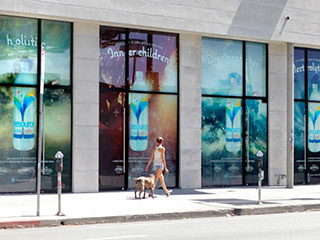 |
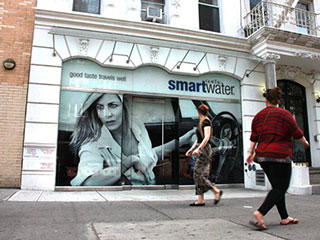 |
| Building on Melrose Avenue with large in-window displays | Building in New York with large in-window displays |
Naturally an advertising display must be protected from indefatigable human drive to spoil or steal. For this reason LCD displays are encapsulated in metal protective cases, front panels are covered with shockproof glass, all interface zones are concealed from reach. In secure indoor areas this is fairly easy to ensure. The protective measures lead to some increase in display cost. The experts estimate that the antivandal precautions may result in a 40% cost increment on the average. However these expenses are justified by a longer service life and high advertising prices.
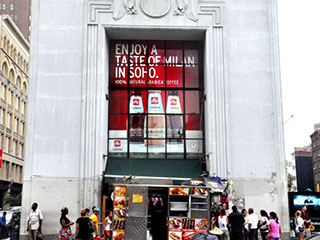 |
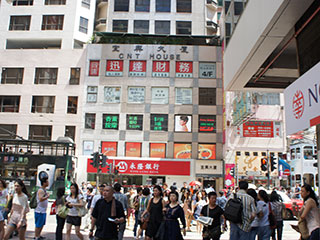 |
| In-window LCD video wall in a New York street | Wing Lung Bank in Hong Kong with all windows converted into displays |
Today when the price of a medium-sized LCD display almost equals the price of a printed poster, LCD advertising displays become much more attractive. No only LCD displays are brighter, more dynamic and attractive. They are also cheaper and long-lasting carriers: digital content is delivered instantaneously and without additional cost. As a result, LCD displays are installed at the ever-increasing pace all around the world cities. The digital networks of the leading advertising operators already count in thousands.
Simultaneously we observe one more important tendency: LCD displays are slowly emerging in the outdoor space. Previously this was not done for one reason: LCD displays are not particularly bright to counteract direct sunshine and image all but disappears. Modern LCD displays are brighter and timidly start venturing outside.
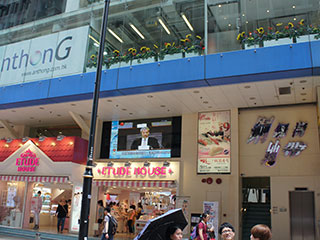 |
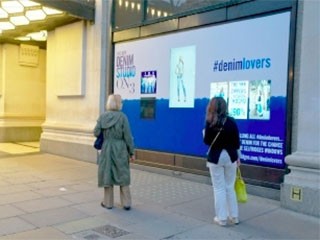 |
| Large display behind the window on a façade in Hong Kong | Advertising in-window display at Selfridges in London |
Advertisers are ready to experiment with new outdoor carrier for many reasons. One of them is the permanent on-going battle of municipal authorities the world over with the large outdoor advertising structures and LED displays. As a result of these legal battles city advertising structures started to shrink. A new concept of “street furniture” and “city format” appeared. Naturally, this format ideally fits the traditional static posters. However today a priority is given to developing digital advertising networks. Whatever the case, installing LCD displays outdoor is not common. The main exception is the so called semi-outdoor installations, e.g. public transport stops with interactive informational systems.
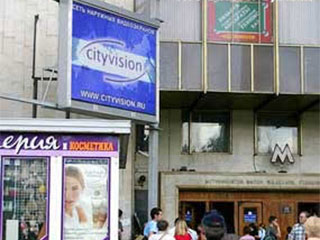 |
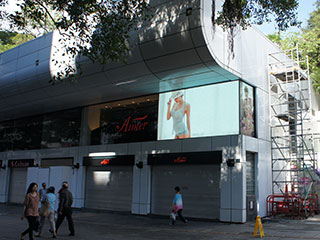 |
| Outdoor LED SMD screen in Moscow in 2004, one of the first of its kind | Outdoor LED SMD screen in Hong Kong behind the window |
A long time ago, some advertising company in Moscow decided to experiment with a new emerging technology and placed a 10 sq. m SMD LED display behind a transparent plastic cover. The project cost was staggering: 300 thousand USD but this was way back in 2004. The experiment was successful. The screen was oriented not to face the sun while the plastic protected SMD display from moisture. The display worked for several years without glitches. But the high price of SMD displays prevented advertisers to expand the network.
The most promising and fast developing trend today are the in-window displays. Hidden behind the window the display is working in relatively comfortable conditions of the indoor space: the window and the façade of the building protects the display from direct sunlight. Thus, the owners of a company (shops, offices or service company) can choose themselves which display to install: LED, LCD or rear-projection. Especially useful are the in-window displays for banks. The displays behind the window are significantly more attractive and informative compared to traditional posters and can advertise numerous bank services and programs all day and night long.
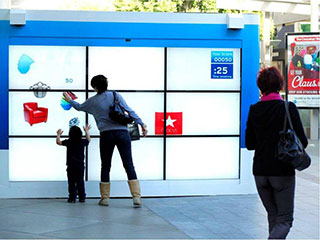 Interactive videowall in Century City Mall
Interactive videowall in Century City MallThe decisive argument in favour of in-window installation is the simplicity of the process. There is no need to ask permission from city administration, to arrange additional security measures to protect or insure the in-window display. Probably, this is the reason why in-window displays started appearing everywhere. Many advertisers are not satisfied with a simple broadcast of advertising clips. Modern displays are intellectual and frequently have the useful touch-screen function. Indoor touch-screen displays have already become a permanent feature in supermarkets, hotels and office buildings.
It is only natural that the owners of such in-window displays prefer interactive screens in the hope to attract more attention from potential customers. The interactive technology is gradually coming out from indoor into outdoor space. For example, the American credit facility Grow Financial conducted promotion using interactive games in the in-window displays of their office in Tampa (Florida).
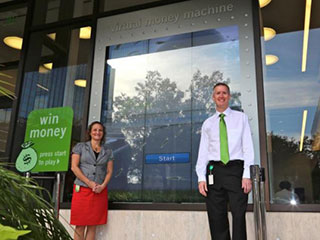 |
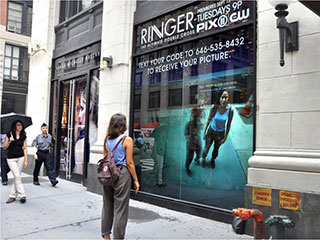 |
| Interactive in-window display at Grow Financial office in Tampa (Florida) | Interactive in-window display with the video camera |
In some cases in-window displays are equipped with video cameras with direct feed to the screen. The interested passers-by are prompted to send a text message and receive a photo to their phone. There may be hundreds of other similar creative approaches. For example, a beautiful Cadillac rushes through in-window displays at the luxury car dealership in Tampa. Gradually, as the number of in-window displays is growing they become a part of façade decoration and significantly transform the way our streets look.
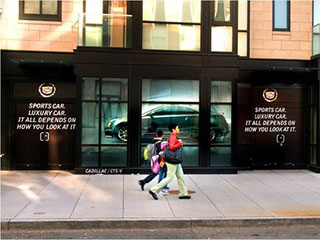 |
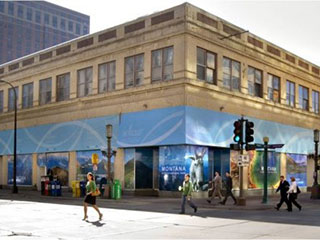 |
| The display behind the window of Cadillac car dealership | The advertising campaign of Storescape at in-window displays in Minneapolis (USA) |
In the modern world the period between invention and its implementation is getting shorter and shorter. This is exactly what we observe in the streets of different cities when we consider the topic of in-window displays.





